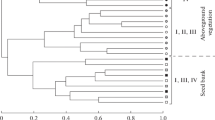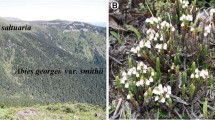Abstract
The patterns of formation of thickets of the invasive vegetatively mobile shrub Sorbaria sorbifolia were studied. The study was carried out in urbanized southern taiga pine forests—forest parks of Yekaterinburg. The density, length and diameter of shoots, and their volume were determined in the center and on the periphery of three thickets of S. sorbifolia on 60 plots of 0.25 m2. The age of 64 shoots was determined by annual tree rings. In the ontogeny of an individual shoot up to 5–7 years, growth is slow, the maximum growth rate is reached at 7–15 years; after 15 years, the morphological parameters of shoots cease to increase noticeably. The average length and diameter of the shoot are 2 times greater from the periphery to the center of thickets, and the volume of one shoot is 8–9 times greater. The total volume of shoots per unit area is 6–6.5 times higher in the center of thickets than in the periphery. Young (1–5 years old) shoots absolutely predominate in the marginal zones. In the center of the thickets, there is a significant proportion of cohorts whose age is more than 10 years, but shoots aged 1–5 years make up more than half of all shoots. It was concluded that the ability of S. sorbifolia to manifest the properties of a transforming plant in the secondary range can be satisfactorily explained by the special structure of its thickets, which have no analog in the forest communities of the Middle Urals.


Similar content being viewed by others
REFERENCES
Dickson, T.L., Hopwood, J.L., and Wilsey, B.J., Do priority effects benefit invasive plants more than native plants? An experiment with six grassland species, Biol. Invasions, 2012, vol. 14, pp. 2617–2624. https://doi.org/10.1007/s10530-012-0257-2
Vilà, M., Rohr, R.P., Espinar, J.L., et al., Explaining the variation in impacts of non-native plants on local-scale species richness: the role of phylogenetic relatedness, Global Ecol. Biogeogr., 2015, vol. 24, no. 2, pp. 139–146. https://doi.org/10.1111/geb.12249
Porté, A.J., Lamarque, L.J., Lortie, C.J., et al., Invasive Acer negundo outperforms native species in non-limiting resource environments due to its higher phenotypic plasticity, BMC Ecol., 2011, vol. 11, p. 28. https://doi.org/10.1186/1472-6785-11-28
Veselkin, D.V., Dubrovin, D.I., and Pustovalova, L.A., High canopy cover of invasive Acer negundo L. affects ground vegetation taxonomic richness, Sci. Rep., 2021, vol. 11, p. 20758. https://doi.org/10.1038/s41598-021-00258-x
Ehrenfeld, J.G., Structure and dynamics of populations of japanese barberry (Berberis thunbergii DC.) in deciduous forests of New Jersey, Biol. Invasions, 1999, vol. 1, pp. 203–213. https://doi.org/10.1023/A:1010066810897
Charles-Dominique, T., Edelin, C., and Bouchard, A., Architectural strategies of Cornus sericea, a native but invasive shrub of Southern Quebec, Canada, under an open or a closed canopy, Ann. Bot., 2010, vol. 105, no. 2, pp. 205–220. https://doi.org/10.1093/aob/mcp273
Brantley, S.T. and Young, D.R., Linking light attenuation, sunflecks, and canopy architecture in mesic shrub thickets, Plant Ecol., 2010, vol. 206, no. 2, pp. 225–236. http://www.jstor.org/stable/40540355
Dalke, I.V., Chadin, I.F., Zakhozhiy, I.G., et al., Traits of Heracleum sosnowskyi plants in monostand on invaded area, PloS One, 2015, vol. 10, no. 11, pp. 1–17. https://doi.org/10.1371/journal.pone.0142833
Deering, R.H. and Vankat, J.L., Forest colonization and developmental growth of the invasive shrub Lonicera maackii, Am. Midl. Nat., 1999, vol. 141, no. 1, pp. 43–50. https://doi.org/10.1674/0003-0031(1999)141[0043:FCADGO]2.0.CO;2
Panasenko, N.N. and Anishchenko, L.N., Influence of invasive plants Parthenocissus vitacea and Vinca minor on biodiversity indices of forest communities, Contemp. Probl. Ecol., 2018, vol. 11, no. 6, pp. 614–623. https://doi.org/10.1134/S1995425518060070
Aksenov, E.S. and Aksenova, N.A., Decorative plants. Vol. 1. (Trees and shrubs), Entsiklopediya prirody Rossii (Encyclopedia of Nature of Russia), Moscow: ABF, 2000.
Panasenko, N.N., Plants-transformers: sings and features of allocation, Vestn. Udmurt. Univ., 2013, vol. 6, no. 2, pp. 17–22.
Vinogradova, Yu.K., Mayorov, S.R., and Khorun, L.V., Chernaya kniga flory Srednei Rossii: chuzherodnye vidy rastenii v ekosistemakh Sredney Rossii (Black Data Book of the Flora of Central Russia: Alien Plant Species in Ecosystems of Central Russia), Moscow: GEOS, 2010.
Tretyakova, A.S., Patterns of formation and ecological structure of the flora of urbanized territories of the Middle Urals (Sverdlovsk Region), Doctoral (Biol.) Dissertation, Yekaterinburg, 2016.
Veselkin, D.V., Zolotareva, N.V., Lipikhina, Y.A., et al., Diversity of plants in thickets of invasive Sorbaria sorbifolia: differences in the effect on aboveground vegetation and seed bank, Russ. J. Ecol., 2020, vol. 51, pp. 518–527. https://doi.org/10.1134/S1067413620060090
Veselkin, D.V., Dubrovin, D.I., Rafikova, O.S., et al., Shading and light interception in thickets of invasive Acer negundo and Sorbaria sorbifolia, Russ. J. Biol. Invasions, 2022, vol. 13, no. 1, pp. 22–31. https://doi.org/10.1134/S2075111722010155
Kulikov, P.V., Zolotareva, N.V., and Podgayevskaya, E.N., Endemichnyye rasteniya Urala vo flore Sverdlovskoy oblasti (Endemic Plants of the Urals in the Flora of Sverdlovsk Region), Yekaterinburg: Goshchitskii, 2013.
Zolotareva, N.V., Podgaevskaya, E.N., and Shavnin, S.A., Structural changes in the soil surface cover of pine forests under the conditions of a large industrial city, Izv. Orenb. Agrar. Univ., 2012, vol. 37, no. 5, pp. 218–221.
Veselkin, D.V., Korzhinevskaya, A.A., and Podgayevskaya, E.N., The species composition and abundance of alien and invasive understory shrubs and trees in urban forests of Yekaterinburg, Vestn. Tomsk. Gos. Univ., Biol., 2018, vol. 42, pp. 102–118. https://doi.org/10.17223/19988591/42/5
Veselkin, D.V. and Korzhinevskaya, A.A., Spatial factors of the alien understory shrubs and trees distribution in urban forests of large city, Izv. Akad. Nauk, Ser. Geogr., 2018, no. 4, pp. 54–64. https://doi.org/10.1134/S2587556618040167
Serebryakov, I.G., Growth forms of higher plants and their study, in Polevaya geobotanika (Field Geobotany), Moscow: Nauka, 1964, pp. 146–205.
Mazurenko, M.T. and Khokhryakov, A.P., Struktura i morfogenez kustarnikov (Structure and Morphogenesis of Shrubs), Moscow: Nauka, 1977.
Flora SSSR (Flora of the USSR), Moscow–Leningrad: Izd. Akad. Nauk SSSR, 1939, vol. 9.
Flora Sibiri. Rosaceae. (Flora of Siberia. Rosaceae.), Novosibirsk: Nauka, 1988.
Jurševska, G., Invasive tree taxa in major dendrological plantations in Jelgava district, Acta Biol. Univ. Daugavpiliensis, 2007, vol. 7, no. 2, pp. 149–158.
Dobravolskaitė, R. and Gudžinskas, Z., Alien plant invasion to forests in the vicinity of communal gardens, Bot. Lith., 2011, vol. 17, nos. 2–3, pp. 73–84.
Lukatkin, A.S., and Khapugin, A.A., Invasive plant species in the flora of Saransk, Sbornik materialov XX Mezhdunarodnogo nauchno-prakticheskogo foruma “Problemy ozeleneniya krupnykh gorodov” (Proc. XX Int. Sci. Pract. Forum “Problems of Landscaping of Large Cities”), Moscow: Pero, 2018, pp. 67–70.
Shipchinsky, N.V., Sorbaria A. Br., Derevia i kustarniki SSSR (Trees and Shrubs of SSSR), Moscow: Akad. Nauk SSSR, 1954, vol. 3, pp. 334–340.
Fedoseeva, G.P., Blagodatkova, T.S., and Okoneshnikova, T.F., Optimization of greening in the city of Yekaterinburg, Izv. Irkuts. Gos. Univ., Ser. Biol. Ekol., 2011, vol. 4, no. 2, pp. 94–108.
Shiyatov, S.G., Vaganov, E.A., Kirdyanov, A.V., et al., Metody dendrokhronologii. Chast I. Osnovy dendrokhronologii. Sbor i poluchenie drevesno-koltsevoy informatsii: Uchebno-metodicheskoye posobie (Methods of Dendrochronology. Part I. Fundamentals of Dendrochronology. Collecting and Obtaining Tree-Ring Information: Educational and Methodical Manual), Krasnoyarsk: Krasnoyarsk. Gos. Univ., 2000.
Ye, X.H., Yu, F.H., and Dong, M., A trade-off between guerrilla and phalanx growth forms in Leymus secalinus under different nutrient supplies, Ann. Bot., 2006, vol. 98, no. 1, pp. 187–191. https://doi.org/10.1093/aob/mcl086
Smirnova, O.V., Palenova, M.M., and Komarov, A.S., Ontogeny of different life forms of plants and specific features of age and spatial structure of their populations, Ontogenez, 2002, vol. 33, no. 1, pp. 5–15.
Firsov, G.A. and Tkachenko, K.G., The quality of seeds of Sorbaria sorbifolia and Sorbaria kirilowii (Rosaceae) at the North-Western Russia, Byull. Bot. Sada, 2016, no. 16, pp. 22–28.
Sitte, P., Weiler, E.W., Kadereit, J.W., et al., Lehrbuch der Botanik, Spektrum Akademischer Verlag, 2002.
Panetta, F.D. and Gooden, B., Managing for biodiversity: impact and action thresholds for invasive plants in natural ecosystems, NeoBiota, 2017, vol. 34, no. 2, pp. 53–66. https://doi.org/10.3897/neobiota.34.11821
Rusterholz, H., Schneuwly, J., and Baur, B., Invasion of the alien shrub Prunus laurocerasus in suburban deciduous forests: effects on native vegetation and soil properties, Acta Oecol., 2018, vol. 92, pp. 44–51. https://doi.org/10.1016/j.actao.2018.08.004
Koropachinsky, I.Yu. and Vstovskaya, T.N., Drevesnyye rasteniya Aziatskoy Rossii (Woody Plants of Asiatic Russia), Novosibirsk: Geo, 2002.
Davletshina, G.T. and Ulanova, N.G., Red raspberry, Biologicheskaya flora Moskovskoy oblasti (Biological Flora of the Moscow Region), Moscow: Mosk. Gos. Univ., 1996, vol. 12, pp. 89–112.
Marshall, B., Harrison, R.E., Graham, J., et al., Spatial trends of phenotypic diversity between colonies of wild raspberry Rubus idaeus, New Phytol., 2001, vol. 151, no. 3, pp. 671–682. https://doi.org/10.1046/j.0028-646x.2001.00220.x
Bystrushkin, A.G., The ontogeny and age variability of raspberry Rubus idaeus L.s.str. (Rosaceae), Vestn. Kurgan. Gos. Univ., Estesv. Nauki, 2017, vol. 47, no. 4, pp. 18–22.
Whitney, G.G., A demographic analysis of Rubus idaeus and Rubus pubescens, Can. J. Bot., 1986, vol. 64, no. 12, pp. 2916–2921. https://doi.org/10.1139/b86-385
Pyšek, P., Richardson, D.M., Rejmánek, M., et al., Alien plants in checklists and floras: towards better communication between taxonomists and ecologists, Taxon, 2004, vol. 53, no. 1, pp. 131–143. https://doi.org/10.2307/4135498
Reinhart, K.O. and Callaway, R.M., Soil biota and invasive plants, New Phytol., 2006, vol. 170, pp. 445–457. https://doi.org/10.1111/j.1469-8137.2006.01715.x
Dorning, M. and Cipollini, D., Leaf and root extracts of the invasive shrub, Lonicera maackii, inhibit seed germination of three herbs with no autotoxic effects, Plant Ecol., 2006, vol. 184, no. 2, pp. 287–296.
El-Keblawy, A. and Al-Rawai, A., Impacts of the invasive exotic Prosopis juliflora (Sw.) DC on the native flora and soils of the UAE, Plant Ecol., 2007, vol. 190, no. 1, pp. 23–35.
Keane, R. and Crawley, M.J., Exotic plant invasions and the enemy release hypothesis, Trends. Ecol. Evol., 2002, vol. 17, no. 4, pp. 164–170. https://doi.org/10.1016/S0169-5347(02)02499-0
Liebhold, A.M., Brockerhoff, E.G., Kalisz, S., et al., Biological invasions in forest ecosystems, Biol. Invasions, 2017, vol. 19, no. 11, pp. 3437–3458. https://doi.org/10.1007/s10530-017-1458-5
Shields, J.M., Jenkins, M.A., Saunders, M.R., et al., Age distribution and spatial patterning of an invasive shrub in secondary hardwood forests, For. Sci., 2014, vol. 6, no. 5, pp. 830–840. https://doi.org/10.5849/forsci.13-079
ACKNOWLEDGMENTS
The authors are grateful to: Doctor of Biological Sciences L.I. Agafonov (Institute of Plant and Animal Ecology, Ural Branch, Russian Academy of Sciences) for consultations on the methodology for determining the age of shoots; O.S. Rafikova (Institute of Plant and Animal Ecology, Ural Branch, Russian Academy of Sciences) for comments on the manuscript.
Funding
The study was carried out within the Russian Science Foundation project no. 22-24-20149.
Author information
Authors and Affiliations
Corresponding author
Ethics declarations
CONFLICT OF INTEREST
The authors declare that they do not have a conflict of interest.
COMPLIANCE WITH ETHICAL STANDARDS
This article does not contain any studies involving humans and animals as research subjects.
Additional information
Translated by M. Shulskaya
Rights and permissions
About this article
Cite this article
Lipikhina, Y.A., Zolotareva, N.V., Podgaevskaya, E.N. et al. The Thicket Structure Explains Sorbaria sorbifolia’s Ability to Be a Transformer in the Secondary Range. Russ J Ecol 53, 456–463 (2022). https://doi.org/10.1134/S106741362206008X
Received:
Revised:
Accepted:
Published:
Issue Date:
DOI: https://doi.org/10.1134/S106741362206008X




